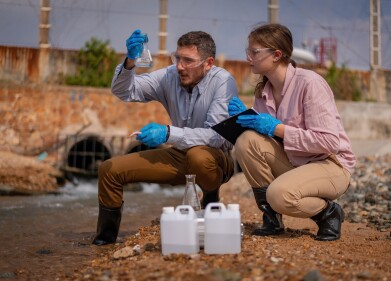Water/wastewater
Which Contaminants Are in Stormwater?
Oct 01 2019
Heavy thunderstorms are something of a double-edged sword in the northern hemisphere. While they can be incredibly fun to watch from a safe distance and can play a vital role in cleansing the air and removing pollutants from our oxygen supply, they also come with a host of less agreeable consequences. For one thing, particularly extreme weather events can have disastrous consequences, destroying homes, roads and other infrastructure, as well as endangering human life.
One less publicised but equally problematic side-effect of cyclones, blizzards and other heavy downpours are the stormwater they generate – and, specifically, how this can wash harmful contaminants into other bodies of water such as rivers, lakes and reservoirs. Now, a new study from the American Chemical Society (ACS) has quantified just how damaging that impact could be by analysing samples of rainwater collected from 50 different storms and identifying the contaminants contained within.
Disturbing results
The research utilised innovative online water quality monitoring techniques to create the most comprehensive overview of how stormwater affects contaminant concentrations across the US to date. The team behind it looked at water samples collected after 50 different storm events at 21 unique sites across the country, analysing the liquid to determine if contaminants from a list of 500 chemicals were present and in what concentrations they could be found.
The results did not make for easy reading. Each sample was found to contain a median of 73 organic chemicals, with those used in fertilisers and pesticides being the most commonly-occurring substance. Indeed, 11 contaminants were found to be present in over 90% of the samples tested, including substances such as caffeine, nicotine, bisphenol A (an integral component in many plastics) and DEET (an insect repellent). What’s more, the presence of both prescription and non-prescription drugs indicated that the samples had been compromised by human waste, either from sewage leaks, improper wastewater treatment methods or other urban sources.
Inconclusive but concerning implications
The bottom line reached by the researchers was that their study threw up more questions than answers, although it did suggest that the current state of affairs is not a healthy one. Given the prevalence of pesticides and other farming chemicals, the paper underlined the agriculture-water interface and its critical impact on the environment, pointing towards the need for greater controls in that industry.
Meanwhile, some contaminants were found to be present in levels already known to be damaging to marine life, in itself a huge cause for concern. However, the precise effect of low-concentration contamination of the waters is not fully understood and when these chemicals are allowed to interact with others present in the water, the impact becomes even more opaque. Therefore, the authors of the study insist that further work must be undertaken to better comprehend both the short- and long-term effect of these contaminants on aquatic organisms.
Digital Edition
IET 35.2 March
April 2025
Air Monitoring - Probe Sampling in Hazardous Areas Under Extreme Conditions - New, Game-Changing Sensor for Methane Emissions - Blue Sky Thinking: a 50-year Retrospective on Technological Prog...
View all digital editions
Events
Apr 08 2025 Birmingham, UK
Apr 08 2025 Targi Kielce, Poland
Apr 08 2025 Baku, Azerbaijan
Apr 08 2025 Bahrain
Apr 10 2025 Beijing, China



















